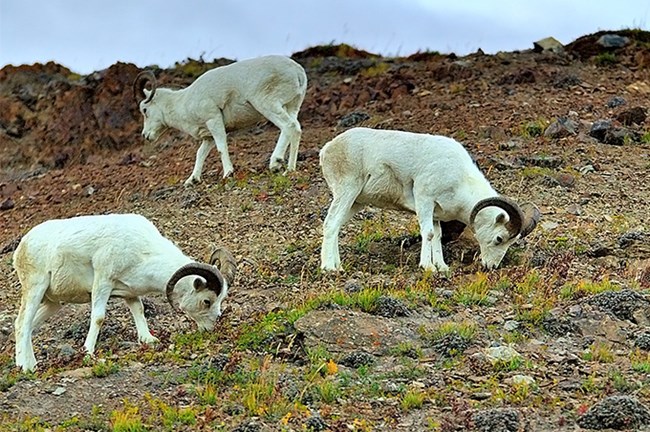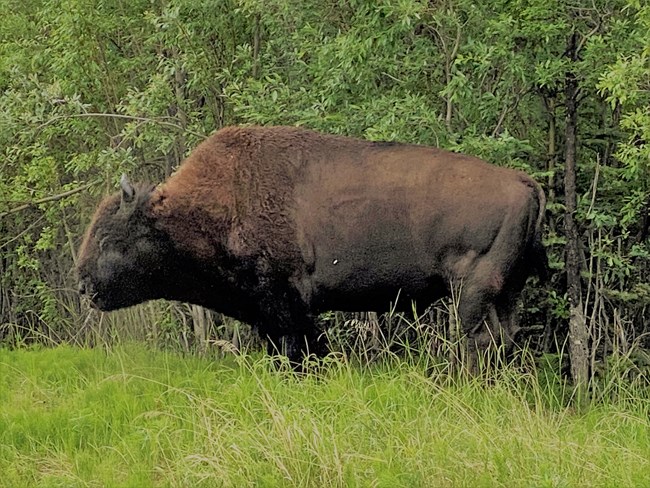
NPS Wrangell-St. Elias is home to many species of mammals, and contains one of the largest concentrations of Dall sheep in North America — some 13,000 sheep in excellent habitat. Look for them along rocky ridges and mountainsides. Moose are often seen near willow bogs and lakes. Other species of large mammals include mountain goats, caribou, wolves, and two herds of transplanted bison. One of the things that makes Alaska so special is that all three species of North American bears flourish here. There is a chance that you may be lucky enough to see a bear. But even if you don't you will never be far from one, because Alaska is bear country! Grizzly/Brown Bears are found from the islands of southeastern Alaska to the arctic. Brown Bears inhabit most of Alaska's forests as well as coastal areas. Black Bears also inhabit most of Alaska's forests but do not inhabit the Seward Peninsula or north of the Brooks Range. Polar Bears frequent the pack ice and tundra of extreme northern and western Alaska. Bears are curious, intelligent and potentially dangerous animals, but undue fear of bears can endanger both bears and people. Many bears are killed each year by people who are afraid of them. Respecting bears and learning proper behavior in their territory will help so that if you encounter a bear, neither of you will suffer needlessly from the experience. Most bears tend to avoid people. In most cases, if you give a bear the opportunity to avoid you, it will. Many bears live in Alaska and many people enjoy the outdoors, but surprisingly few people even see bears. Only a tiny percentage of those few are ever threatened by a bear. A study by the state epidemiology department showed that more people are attacked by dogs than by bears. Most people who see a bear in the wild consider it the highlight of their trip. The presence of these majestic creatures is a reminder of how privileged we are to share some of the country's most amazing wilderness. Black bears and brown bears (grizzlies) are found throughout the park and preserve. Grizzlies are yellowish-brown to black and some have white-tipped hairs, giving them a grizzled appearance. The bears' height at the shoulders ranges from about 4.5 feet to six or seven feet, and they weigh between 300 and 1,500 pounds. When standing they may measure up to nine feet tall. They have a large hump of muscle above their shoulders which helps them dig up one of their favorite foods...ground squirrels. Other foods vary by the season and include grasses, roots, berries, nuts, insects, salmon, rodents, and sometimes large mammals (moose, caribou, Dall sheep).Brown bears can conceal themselves remarkably well in the low brush along hill sides. Bears are actively hunted throughout Alaska and tend to be shy around people, but they will aggressively defend their young or their food if surprised or approached too closely. They have an excellent sense of smell, good hearing, and are extremely powerful. They are naturally curious, and caution should be taken when in their presence. Before heading into the backcountry, know how to be "bear aware." Small mammals found in the park and preserve include lynx, wolverine, beaver, marten, porcupine, fox, coyotes, marmots, river otters, ground squirrels, pikas, and voles. The coastal areas of the park are habitat for marine mammals, including sea lions, harbor seals, sea otters, porpoises, and whales. 
Photo by Jamie Hart NPSpecies Mammals Checklist Our wildlife biologists keep track of mammal species within the park. They are documented within a database called NPSpecies. If you'd like to view or print out the most updated checklist of mammal species, please follow these directions: NPSpecies is best viewed in Internet Explorer.
Open NPSpecies (https://irma.nps.gov/NPSpecies/) Choose Wrangell-St. Elias National Park & Preserve from the drop-down list and click "Go". Choose the category "Mammals". Then click the "Search" button. Finally, click the "Report/Pdf" button. View or print the mammal checklist.

NPS Photo by Bryan Petrtyl Threatened & Endangered Species of Mammals The US Fish and Wildlife Service lists 10 endangered and threatened species in the state of Alaska. The only federally listed mammals that could occur within Wrangell-St. Elias are marine mammals with jurisdictional responsibilities with National Marine Fisheries (NMF) and National Marine Sanctuaries (NMS).

Jesse Heinbaugh BisonDuring the Ice Age, steppe bison, the ancestors of modern bison, migrated into Alaska from Asia, crossing the Bering Land Corridor. Far larger than modern buffalo, with longer horns, these giant herbivores shared the tundra of prehistoric Alaska with wild horses, wooly mammoths, and western camels. As ice sheets advanced and retreated, the migratory bison dispersed across North America. Temporary advancements of glaciers isolated populations, and bison evolved into two subspecies, wood bison and the smaller plains bison. The giant longhorn steppe bison became extinct. Wood bison adapted to life in the north, grazing in the boreal meadows and forests of Alaska and Canada. The smaller plains bison thrived further south, and formed the famous buffalo herds of the American Great Plains. Wood bison disappeared from Alaska several hundred years ago, probably the result of hunting and changing habitat. In 1928, twenty three plains bison from Montana were introduced at Delta Junction. At the time they were introduced, it was not known that a small population of wood bison existed in Canada. State wildlife biologists are working to reintroduce these northern adapted giants to part of their former range in Alaska, and animals from the Canadian herd have been selected to pioneer this new Alaska herd. Four herds of plains bison totaling about 900 animals graze in Alaska. The largest herd is near Delta Junction, and smaller herds have been established by translocation from the Delta herd to Farewell, Chitina River, and the Copper River. |
Last updated: February 24, 2023
